#labeled by company and year back to the 1960s
Text

Pink Anderson (1900-1974)
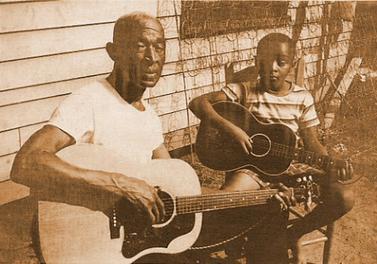
Pink Anderson was a historic figure whose music included Piedmont-style blues, folk music, ragtime, and traditional ballads. He was born in South Carolina and early on sang in the streets for pennies. He was self-taught as a guitarist and toured throughout the Southeast with a variety of medicine shows (including Dr. William R. Kerr's "cure all medicine") during 1915-1945, picking up work wherever he could. He was employed not only as a musician and a singer but as a dancer and comedian.
Anderson recorded four titles in 1928 but did not make another record until Harlem Street Spirituals in 1950 for Riverside. At that time he recorded such traditional folk material as “John Henry,’ ‘The Ship Titanic,” and “Wreck of the Old 97.” He continued to work at parties, street fairs, and medicine shows during the first half of the 1950s before retiring for a time due to ill health. But in 1961, the Bluesville label recorded three albums of unaccompanied performances by Anderson, documenting him in Spartanburg, South Carolina. The titles of the three records, Carolina Blues Man, Medicine Show Man, and Ballad & Folksinger, vol. 3, sum up Pink Anderson’s life well and are a large slice of the repertoire that he had performed during the previous 35 years.
Pink Anderson stayed active on a part-time basis up until the time of his death in 1974. His music represents the Carolina blues, and the tradition of the constantly traveling folk singer.
Source
Floyd Council (1911-1976)
Floyd Council was a blues singer and guitar slinger who played in the East Coast / Piedmont style. He didn’t record solo often, but he’s still said to have recorded 27 songs, many backing up the legendary Blind Boy Fuller.
Born in North Carolina, Floyd began his musical career on the streets of Chapel Hill in the 1920s, performing with two brothers, Leo and Thomas Strowd as “The Chapel Hillbillies.” He recorded twice for ARC at sessions with Blind Boy Fuller in the mid-thirties, all examples of the Piedmont style. He was sometimes promoted as ‘Dipper Boy Council’, and ‘The Devil’s Daddy-in-Law,’ but these were likely the invention of record companies, not genuine nicknames.
Council suffered a stroke in the late 1960s which partially paralyzed his throat muscles and slowed his motor skills, but did not significantly damage his cognitive abilities. Folklorist Peter B. Lowry attempted to record him one afternoon in 1970, but he never regained his singing or playing abilities. Accounts say that he remained “quite sharp in mind.” Council died in 1976 of a heart attack, after moving to Sanford, North Carolina.
Source
Pink Floyd

Pink Anderson and Floyd Council were both featured on a Blind Boy Fuller album called Country Blues: 1935-1940. The sleeve of that album caught the eye of Syd Barrett, the frontman for London band, The Tea Set. Barrett changed the band's name to Pink Floyd, and the rest is history.
Source
#pink anderson#floyd council#blind boy fuller#syd barrett#pink floyd#piedmont blues#black american history#music history#thechanelmuse trivia
314 notes
·
View notes
Text
Victoria Spivey

Victoria Regina Spivey (October 15, 1906 – October 3, 1976), sometimes known as Queen Victoria, was an American blues singer, songwriter, and record company founder. During a recording career that spanned 40 years, from 1926 to the mid-1960s, she worked with Louis Armstrong, King Oliver, Clarence Williams, Luis Russell, Lonnie Johnson, and Bob Dylan. She also performed in vaudeville and clubs, sometimes with her sister Addie "Sweet Peas" (or "Sweet Pease") Spivey (August 22, 1910 – 1943). also known as the Za Zu Girl. Among her compositions are "Black Snake Blues" (1926), "Dope Head Blues" (1927), and "Organ Grinder Blues" (1928). In 1961, she co-founded Spivey Records with one of her husbands, Len Kunstadt.
Born in Houston, Texas, she was the daughter of Grant and Addie (Smith) Spivey. Her father was a part-time musician and a flagman for the railroad; her mother was a nurse. She had three sisters, all three of whom also sang professionally: Leona, Elton "Za Zu", and Addie "Sweet Peas" (or "Sweet Pease") Spivey (August 22, 1910 – 1943), who recorded for several major record labels between 1929 and 1937, and Elton Island Spivey Harris (1900–1971). She married four times; her husbands included Ruben Floyd, Billy Adams, and Len Kunstadt, with whom she co-founded Spivey Records in 1961.
Spivey's first professional experience was in a family string band led by her father in Houston. After he died, the seven-year-old Victoria played on her own at local parties. In 1918, she was hired to accompany films at the Lincoln Theater in Dallas. As a teenager, she worked in local bars, nightclubs, and buffet flats, mostly alone, but occasionally with singer-guitarists, including Blind Lemon Jefferson. In 1926 she moved to St. Louis, Missouri, where she was signed by Okeh Records. Her first recording, "Black Snake Blues" (1926), sold well, and her association with the label continued. She recorded numerous sides for Okeh in New York City until 1929, when she switched to the Victor label. Between 1931 and 1937, more recordings followed for Vocalion Records and Decca Records, and, working out of New York, she maintained an active performance schedule. Her recorded accompanists included King Oliver, Charles Avery, Louis Armstrong, Lonnie Johnson, and Red Allen.
The Depression did not put an end to Spivey's musical career. She found a new outlet for her talent in 1929, when the film director King Vidor cast her to play Missy Rose in his first sound film, Hallelujah!. Through the 1930s and 1940s Spivey continued to work in musical films and stage shows, including the hit musical Hellzapoppin (1938), often with her husband, the vaudeville dancer Billy Adams.
In 1951, Spivey retired from show business to play the pipe organ and lead a church choir, but she returned to secular music in 1961, when she was reunited with an old singing partner, Lonnie Johnson, to appear on four tracks on his Prestige Bluesville album Idle Hours.
The folk music revival of the 1960s gave her further opportunities to make a comeback. She recorded again for Prestige Bluesville, sharing an album, Songs We Taught Your Mother, with fellow veterans Alberta Hunter and Lucille Hegamin, and began making personal appearances at festivals and clubs, including the 1963 European tour of the American Folk Blues Festival.
In 1961, Spivey and the jazz and blues historian Len Kunstadt launched Spivey Records, a low-budget label dedicated to blues, jazz, and related music.
In March 1962, Spivey and Big Joe Williams recorded for Spivey Records, with harmonica accompaniment and backup vocals by Bob Dylan. The recordings were released on Three Kings and the Queen and Kings and the Queen Volume Two. Dylan was listed under his own name on the record covers. A picture of her and Dylan from this period is shown on the back cover of the Dylan album, New Morning. In 1964, Spivey made her only recording with an all-white band, the Connecticut-based Easy Riders Jazz Band, led by the trombonist Big Bill Bissonnette. It was released first on an LP and later re-released on compact disc.
Spivey married four times; her husbands included Ruben Floyd, Billy Adams, and Len Kunstadt.
Spivey died in New York on October 3, 1976, at the age of 69, from an internal hemorrhage.
34 notes
·
View notes
Text
youtube
Lost Futures: How greed is destroying our planet | Dying Earth: E1 | Featured Documentary
Some of the 'prophets of doom' of the 60s whose warnings went unheeded assess the current environmental fragility.
The effects of climate change were already being felt as far back as the 1960s, but scientists who linked fossil fuels with climate change were labelled “prophets of doom”.
This episode traces the trajectory of climate change over the past 60 years and examines how and why – despite the stark warnings – we failed to halt the climate catastrophe we are currently experiencing, and why it appears politics and science are at odds when it comes to this issue.
Years of propaganda and greed from oil companies created a world where profit trumped the health of the planet, the consequences of which are now being felt today.
Lost Futures explores the effects of corporate greed. In Louisiana, we see firsthand how small coastal towns will succumb to the devastating effects of years of drilling from oil companies, and what this means for a generation which has had little to do with causing the devastation but is forced to live with its consequences
4 notes
·
View notes
Text
so I’m currently actively looking for a couple pieces of lost (ish? Idk if they were ever officially posted and then removed or just leaked) media and my latest concern is how much research is considered research and not like. stalking.
for the record, I have little to no desire in actually meeting the people that made the things. but since a lot of things relating to the media have been deleted/removed now, and I’ve made my way through all the wayback machine copies of the official stuff, I’m now looking through mostly 3rd party sources, ranging from niche blogposts to people who made content professionally pertaining to said media (like photography etc) to check if it could be referenced/linked on their old portfolio in some way. This does include people who I know tangentially worked with those who made the stuff I’m trying to find (or same management/record label/reporters) — and checking when the partnership began (like if they only started working together 5 years after the lost media I don’t check them).
and it’s just… like where’s the boundary? I’m not looking up addresses or highly personal info, to reiterate, I could not care less about the people who made the media in any way beyond “hey you’re good at what you do thanks for the cool stuff”. But I’m still seeking knowledge about real people (like when they started working with X company, who was in their work/networking circle), and it’s people who are alive today, not archive files from the 1960s. I don’t know if I’m feeling weird about nothing or if this is a very valid concern tbh. I really want to find the media (bc c’mon, I know it’s out there, it is not my fault I was 6/7 and couldn’t download it back then) but I don’t want it to be weird.
2 notes
·
View notes
Text
Discover Jimmy Page
The very beginnings: London's youngest session musician
from pageysartgallery
The very beginning of Jimmy Page’s studio career goes all the way back to 60 years ago, at the start of the 1960s, when a 17 year old Jimmy, following two years of touring with Neil Christian and his band The Crusaders, recorded various tracks with them. The most notable of these is the single "The Road To Love", released in 1962:
During one of his many performances at the Marquee Club, he was spotted by John Gibb of Brian Howard & the Silhouettes, who asked him to help record some singles for Columbia Graphophone Company. My personal favourite is "The Worryin’ Kind", a fast-paced rock and roll number:
youtube
Jimmy was offered regular session work by Mike Leander of Decca Records. His first ever session for the label was "Diamonds", an instrumental track which reached #1 on the singles chart.
“In the initial stages they just said, play what you want, cause at that time I couldn't read music or anything.”
- Jimmy Page
In his early career as a session musician, Page has played with a large number of artists. You may want to check out his work with The Who, The Rolling Stones, Marianne Faithfull, Donovan and Them. Here are some of my favourite tracks from those sessions:
On these two 1964 Kinks tracks, he's credited as playing acoustic twelve-string guitar
He plays rythm guitar on the notorious Who single "I Can't Explain"
...and lead guitar on "Bald Headed Woman"
Some more iconic tracks from that time period include:
Around this time, he also released his first ever solo single, an upbeat pop rock track which has him playing all the instruments except the drums as well as singing lead... Something that has never happened again since (he does have a pretty, slightly raspy voice despite him claiming many times that he can't sing):
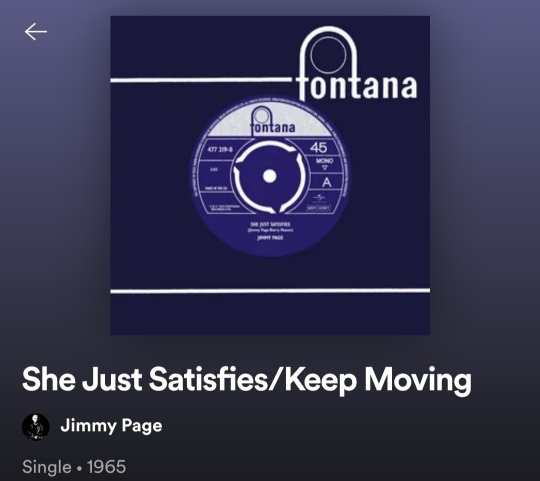
Suggested album:

The Maureeny Wishfull Album (1968), recorded and composed with his session days "rival" Big Jim Sullivan.
There aren’t any filmed live performances available from this time period, so I’m linking this adorable performance from 1957, playing in a skiffle band when he was only 13 years of age:
youtube
AND how could I not include some video footage of Jimmy walking to the studio on a regular day of session work?
youtube
Gallery:




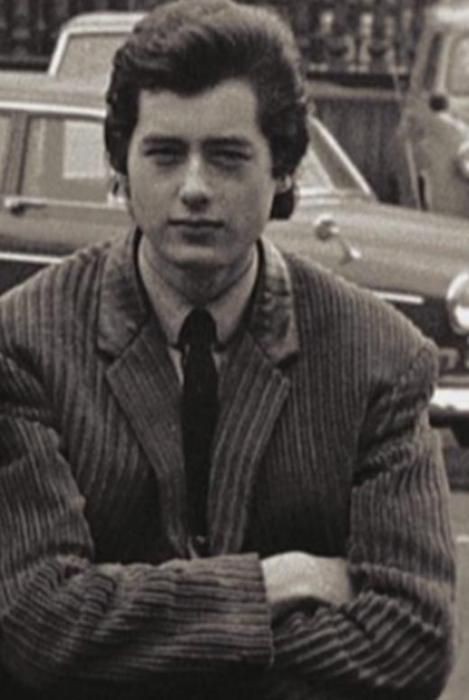



“I finally called it quits after I started getting calls to do Muzak. I decided I couldn’t live that life any more; it was getting too silly. I guess it was destiny that a week after I quit doing sessions Paul Samwell-Smith left the Yardbirds and I was able to take his place. But being a session musician was good fun in the beginning – the studio discipline was great. They’d just count the song off and you couldn’t make any mistakes.”
- Jimmy Page
#jimmy page#led zeppelin#the yardbirds#robert plant#john paul jones#john bonham#classic rock#rock#pagey#led zep#60s#pageysartgallery#Spotify#Youtube#by dee dee 🌺🕯️#discover jp#my writing
63 notes
·
View notes
Photo

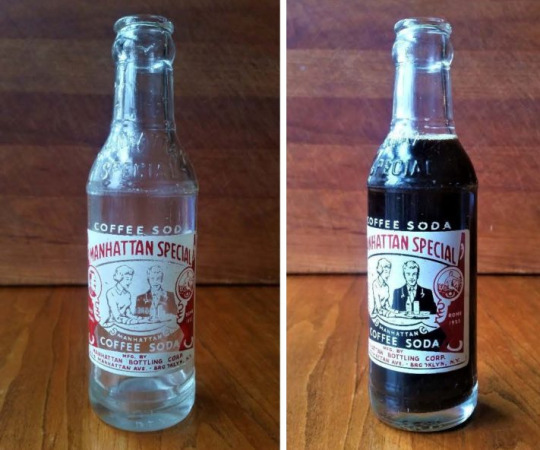
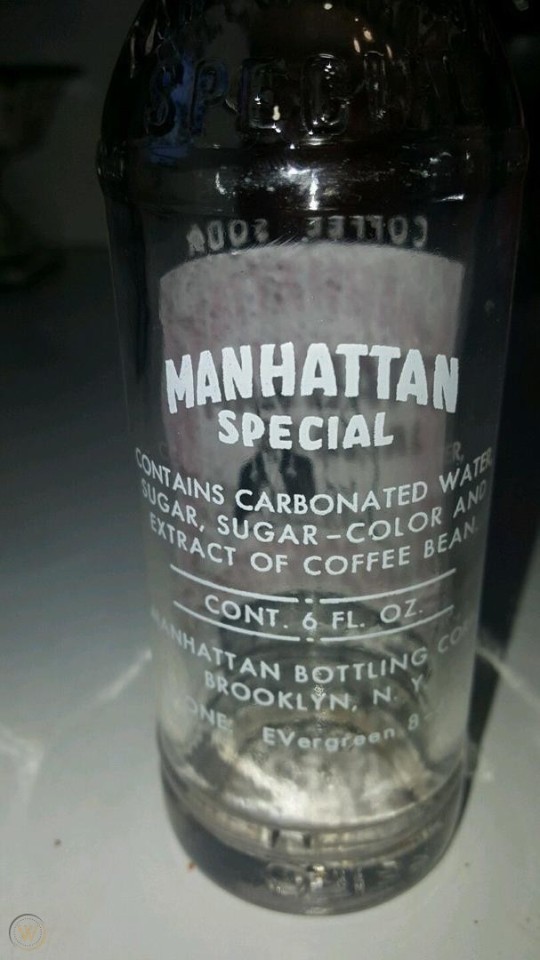


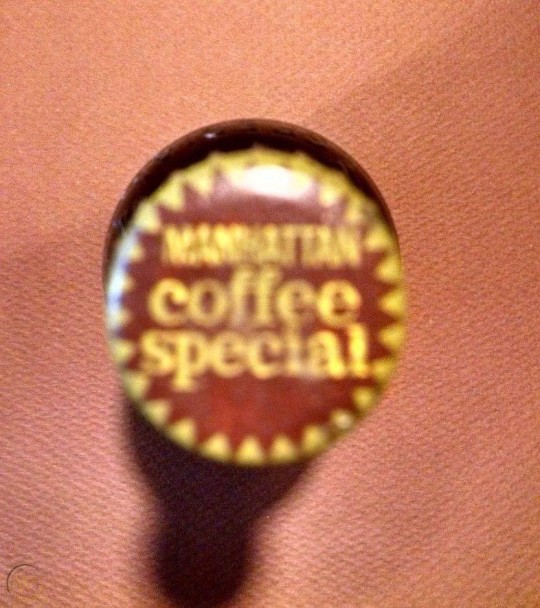

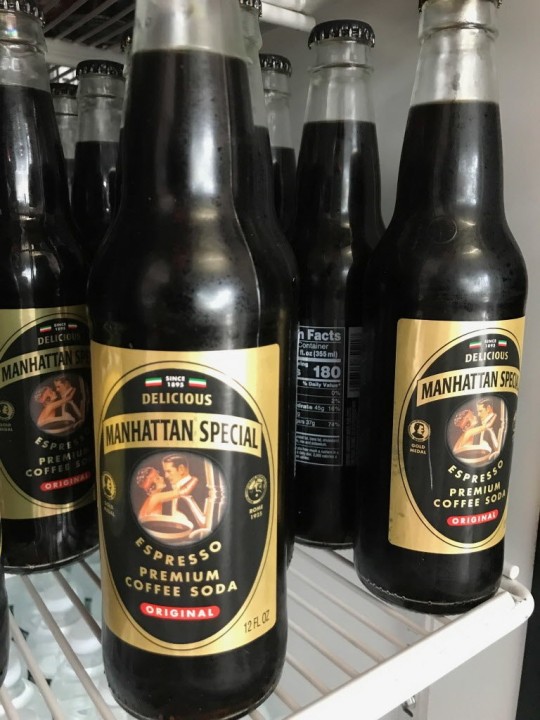
Manhattan Special
Espresso Coffee Soda
This was a really fun find!
Manhattan Special looks to have been a staple of Brooklyn soda fountains and bottle vendors since long before our boys’ time.
The Williamsburg brand Manhattan Special’s Espresso Coffee Soda has been in production since 1895. This signature product is a coffee-based soda, made from just espresso beans, cane sugar, and seltzer. The unique drink is said to have an “acquired taste,” with various reviewers describing it as thick, quite sweet, bodied like a cream soda, smooth, mellow, dark, smoky French roast aroma, deep, tannic, and complex. Also noted by a number of commentators, the soda is very fizzy! So much so that it is not uncommon for the bottles to erupt and overflow upon first opening due to the carbonation. One suggested opening over a glass or sink to account for it.
The images above show the bottle design that would have been found in the years before WWII. The glass bottles were 6-oz, with yellow and maroon metal crown cork caps (pop-top, twist-off caps were not invented until the 1960s). The white and red label was printed directly onto the bottle and featured the company’s direct phone number (EVergreen 8). Raised lettering can also be seen on the upper portion of the glass. The last two images are of the modern versions of the packaging, which underwent a redesign in 2017. The older of the two (left) can still be found in some stockists, while the newer (right) is more commonly available post-2017.
The brand also produces other soda flavours, including black cherry, gassosa (Italian lemon-lime), orange, sasparilla, and vanilla cream.
I love the idea of the boys finding this drink still in production in the 21st century. From all accounts I’ve seen, the recipe does not appear to have changed over the course of its history. So the taste should then be the same if Steve and Bucky were to drink it again in the 21st century!
Images Sources
Label close-up, 1940s-1950s | Source
Empty vs. Full bottle 1940s-1950s | Source
Empty back, 1940s-1950s | Source
Top with raised name, 1940s-1950s | Source
Cap in bottle, 1940s-1950s | Source
Cap, 1940s-1950s | Source
Older modern variation, pre-2017| Source
New modern variation, 2017| Source
The full research document for this topic is available on the Discord’s “Patreon Clubhouse” channel ($3+ donors)

This post has been sponsored by my much loved and long-time Patreon supporter Joanna Daniels. She and I would like to dedicate the post to the loving memory of her mother Joan Daniels. She will be sorely missed.

[ Support SRNY through Patreon and Ko-Fi ]
And join us on Discord for fun conversation!
I also have an Etsy with upcycled nerdy crafts
#Steve Rogers#Soda#Manhattan Special#1940s#Food#1940s Food#1940s Soda#historically accurate#historic new york#historically accurate steve rogers#captain america#Captain America: The First Avenger#captain america tfa#Brooklyn#New York#Meta#Marvel#MCU
27 notes
·
View notes
Text

Joyce with Mauricio Maestro - Natureza (produced, arranged & conducted by Claus Ogerman) [2022]
1. Feminina - 11.25 (Joyce Moreno)
2. Moreno - 4.44 (Joyce Moreno)
3. Coração Sonhador - 5.33 (Claudio Guimarães/Mauricio Maestro)
4. Descompassadamente - 4.59 (Maurício Maestro/Joyce Moreno)
5. Mistérios - 5.32 (Joyce Moreno/Mauricio Maestro)
6. Ciclo Da Vida - 8.35 (Mauricio Maestro)
7. Pega Leve - 3.42 (Joyce Moreno)
Not long after the dawn of her career, as a teenager in Rio de Janeiro, Joyce was declared “one of the greatest singers” by Antonio Carlos Jobim. Yet despite reputable accolades and the fact that she has since recorded over thirty acclaimed albums, Joyce never quite achieved the international recognition of the likes of Jobim, João Gilberto and Sergio Mendes, all of whom became global stars after releasing with major labels in the US.
There was a moment when it seemed Joyce might be on the cusp of an international breakthrough. While living in New York, she was approached by the great German producer Claus Ogerman. Ogerman had already played a pivotal role in the development and popularisation of Brazilian music in the 1960s, recording with some of the all-time greats like Jobim and João Gilberto, as well as North American idols like Frank Sinatra, Billie Holiday and Bill Evans.
“I met him in New York City, in 1977”, recalls Joyce. “I was living and playing there, and João Palma, Brazilian drummer who used to play with Jobim, introduced me to Claus. We had an audition, he liked what we were doing and decided to produce an album with us.”
Featuring fellow Brazilian musicians Mauricio Maestro (who wrote/co-wrote four of the songs), Nana Vasconcelos and Tutty Moreno, and some of the most in-demand stateside players including Michael Brecker, Joe Farrell and Buster Williams, the recordings for Natureza took place at Columbia Studios and Ogerman produced the album, provided the arrangements and conducted the orchestra.
But mysteriously, Natureza was never released, and what should have been Joyce’s big moment never happened. As Joyce remembers, “I returned home, but Claus and I remained in contact, by letters and phone calls. He was very enthusiastic about the album and tried to hook me up with Michael Franks. He wanted me to go back to NYC in order to re-record the vocals in English with new lyrics, which I actually wasn’t too happy about. But then I got pregnant with my third child and could not leave Brazil. And little by little our contact became rare, until I lost track of him completely. And that was it. I never heard from him again.”
While Claus was known to be something of an elusive character, the album’s disappearance might also have been a result of timing. The Brazilian craze was coming to an end, making way for disco and new wave at the end of the seventies, and Ogerman struggled to find a major label interested in his new Brazilian sensation. Additionally, as Joyce mentions, it wasn’t quite finished. Ogerman wanted to add finishing touches to the mix and to record alternative English lyrics for the US and international markets - a critical artistic difference between Joyce and Ogerman.
As the military dictatorship’s grip on Brazil began to subside in the 1980s, Joyce had a handful of hits in her home county, including a tribute to her daughters ‘Clareana’, and the iconic ‘Feminina’ - an intergenerational conversation between mother and daughter about what it means to be a woman. But already a feminist pioneer, these successes were hard fought. Joyce had caused controversy as a nineteen-year-old when she became the first in Brazil to sing from the first-person feminine perspective, and the institutional sexism she faced was worsened by the dictatorship who would often censor her music. Even once the Junta was out of the way, Joyce found herself up against the male-dominated major record companies in Brazil, who sought to dictate her career and sexualise her image, before dropping her for refusing to play along.
A few years after the success of her albums Feminina and Agua E Luz in Brazil, Joyce’s music began to find its way to the UK, Europe and Japan, and ‘Feminina’ and ‘Aldeia de Ogum’ became classics on the underground jazz-dance scenes of the mid to late-eighties and early-nineties.
The full-length version of ‘Feminina’ from the Natureza sessions was first heard on a Brazilian Jazz compilation in 1999 and ‘Descompassadamente’ was licensed for a CD compiling the work of Claus Ogerman in 2002. Following these, word began to get out about an unreleased Joyce album with Claus Ogerman and the legend of Natureza grew.
Forty-five years since it was recorded, Natureza finally sees the light of day, with Joyce’s Portuguese lyrics and vocals, as she intended. Featuring the fabled 11-minute version of ‘Feminina’, as well as the never before heard ‘Coração Sonhador’ composed and performed by Mauricio Maestro, Natureza’s release is a landmark in Brazilian music history and represents a triumphant, if overdue victory for Joyce as an outspoken female artist who has consistently refused to bow to patriarchal pressure.
***Disclaimer! While “Feminina” and “Descompassadamente’’ were mixed by legendary engineer Al Schmitt and mastered from the original master tapes, the remaining five tracks are unmixed. Due to significant deterioration of the master-tapes, the best audio source for these tracks was an unmixed tape copy Joyce had kept of the recordings. The best care has been taken in the restoration and mastering of this release, but the sound quality may differ from other releases on Far Out Recordings. We advise listening to sound clips before buying where possible.
youtube
3 notes
·
View notes
Text

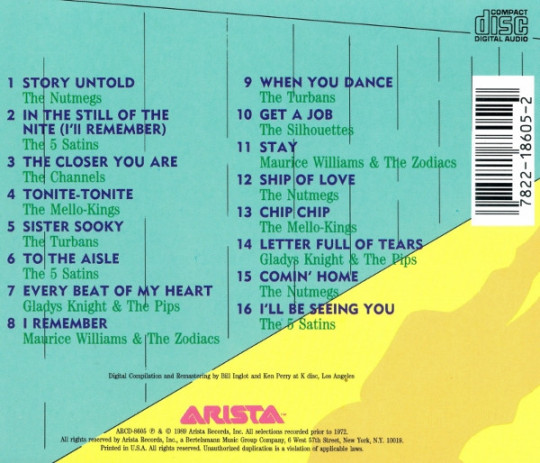
Today's compilation:
Echoes Down the Hall: 16 Original Doo-Wop Classics
1989
Doo Wop / R&B / Soul
Folks, this is probably one of the greatest doo wop comps that I've ever come across in my entire life. Back in 1989, the Arista label put together this little collection of tunes that mostly originated from a pair of different record companies in New York's Greenwich Village: Ember and Herald, both run by a guy named Al Silver.
Now, the most famous song to ever come out of either of those labels was undoubtedly 1960's "Stay," by Maurice Williams & the Zodiacs, which features group member Henry Gaston's sudden and iconically *glorious* falsetto (🎶Ohh, won't you staaaaay, just a little bit longerr?🎶). And for a fun bit of trivia, that tune also happens to hold the honor of being the shortest song to ever reach #1 on the Billboard Hot 100 chart, clocking in at just a mere 100 seconds.
But as this CD plainly shows, there was a lot more greatness to both Ember and Herald than just "Stay." You can find superb examples of a dynamic vocal doo wop group sound all throughout this release, whether it be slowly swaying, lovey-dovey, Makeout Point ballads, like The Five Satins' "In the Still of the Night (I'll Remember)"—which was given some new life a few years ago thanks to its inclusion in Martin Scorsese's The Irishman—or the more upbeat and uptempo stuff that really loved to utilize those onomatopoeiac vocal basslines, as heard in electric tunes like The Silhouettes' "Get a Job" and The Nutmegs' "Comin' Home." And then there's also a group from Philadelphia on here called The Turbans...who actually wore turbans...that supply a couple other excellent numbers in "Sister Sooky" and "When You Dance," which both go on these terrific, sax-laced R&B detours.
But not *all* of this release is actually made up of Herald and Ember material. A quintet from Harlem called The Channels appear with "The Closer You Are," a song that never managed to chart nationally, but, in hindsight, is often recognized as one of the greatest doo wop ballads that's ever been recorded. It was released in 1956 on a small Manhattan label called Whirlin Disc.
And in a genre that was largely dominated by men, Gladys Knight shines extra brightly on here as well. She and the Pips provide two tracks, but Knight manages to *really* flex her vibrato in an extremely satisfying way on "Every Beat of My Heart," which was released in 1961 on Chicago's Vee-Jay label.
So, if you want a fully functioning music collection that manages to span a whole bunch of decades, you'd do well to look here for some of those mid-50s-to-early 60s golden doo wop oldies. And fortunately for you, this whole album's up on Spotify and YouTube!
Highlights:
The Nutmegs - "Story Untold"
The Five Satins - "In the Still of the Night (I'll Remember)"
The Channels - "The Closer You Are"
The Mello-Kings - "Tonite, Tonite"
The Turbans - "Sister Sooky"
Gladys Knight & the Pips - "Every Beat of My Heart"
The Turbans - "When You Dance"
The Silhouettes - "Get a Job"
Maurice Williams & the Zodiacs - "Stay"
The Nutmegs - "The Ship of Love"
The Nutmegs - "Comin' Home"
2 notes
·
View notes
Text
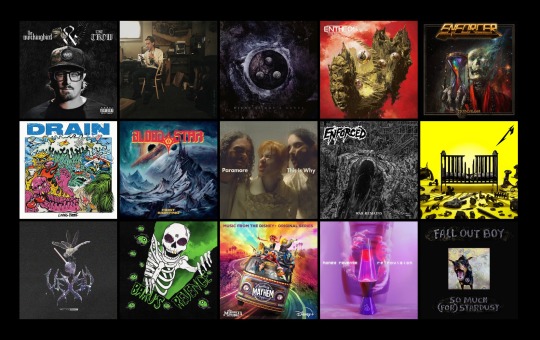
Top 10 Albums Of 2023… So Far! Part Three: 5 - 2
In the last part, we talked about the first half of the list, but in this last part, we're going to talk about the second half, starting with…
Vexed - Negative Energy
In 2021, British nu-metalcore / alternative metal Vexed released their debut LP, Culling Culture, and it was one of my favorite albums of the year. It was in my top five, actually, and that's no exception for the hotly anticipated follow-up, Negative Energy. This record is a nonstop force of nu-metal, metalcore, djent, deathcore, and alt-metal. In a way, it's the same sound that they had on their debut, but it's a tightened up version. Their vocalist is easily their biggest weapon, as she is able to employ many different styles on this record (just as she did on their debut), including deathcore / metalcore growls that are some of the best I've heard in a long time, clean vocals that are equally impressive, or Korn-esque nu-metal whisper vocals that provide a creepy and menacing sound. What's cool about this band is that I wouldn't classify them as nu-metalcore, djent, or deathcore, because they take all of these styles and do something interesting with it. The breakdowns and riffs are aplenty as well, but it's the vocals and lyrics that take center stage. They're brutal, hardhitting, and honest, dealing with things like the weaponization of Christianity, mental health, and the taboo nature of speaking out about abuse and things of that nature. This is a great record, and a more than worthy follow-up to their debut. Hell, I might enjoy this one a bit better.
Magnolia Park - Baku's Revenge (Deluxe)
In November of last year, I reviewed the new album from pop-punk / alt-rock band Magnolia Park, Baku's Revenge, and despite how much I enjoyed it, I had some issues with it. Some of the lyrics weren't very interesting, and a few songs just fell flat compared to the highlights, but going back to the album after the deluxe version was released recently (especially now that the deluxe edition feels like an actual album; the original version was only 24 minutes, and the deluxe edition is 35), I decided to cheat and put the deluxe edition here, because it's a damn good album. While I see why I wasn't originally crazy about it, as some of the issues I have with the record still stand, I've really grown on it. The vocals are utterly incredible, especially with how hooky and sticky sweet this album is. It's got some of the best hooks and melodies I've heard all year. The lyrics have grown on me, too, because there's a lot to them that's underneath the surface, versus just looking at the lyrics at face value. What really did it for me, however, were the four new songs that got added to the record. The four new songs on this record are utterly fantastic, and they make the album a lot better, so for that alone, I felt more compelled to include here, especially for how unique and interesting this band is for the pop-punk scene. I might even re-review this album and talk more about how my feelings have changed and how important this band is for the genre.
Dr. Teeth & The Electric Mayhem - The Muppets Mayhem Soundtrack
The Muppets are one of my favorite franchises, and their new show, The Muppets Mayhem, is no exception. I reviewed the show when it came out earlier this year, despite not going into a lot of detail about it, but I also talked about its soundtrack. The whole basis for the show is that The Muppet Show's in-house band, Dr. Teeth & The Electric Mayhem, still owe an album to a small record label, so the show is them recording the album and getting into hijinks. The album itself is the end result, and it's a fantastic collection of "originals" and covers of some timeless songs from the 1960s - 1980s. It's a fun record that doesn't feel like a product of a franchise, this case being the Muppets and/or Disney, but this is the actual Dr. Teeth and company releasing their debut album after 50 years of being a band. If you enjoy "classic rock," whatever that phrase means now, or The Muppets, you'll surely enjoy this record (and check out the show, it's worth a watch, too).
Honey Revenge - Retrovision
Being that this is most recent album on my list, I almost didn't want to put this so high, but I couldn't help it. I've been playing this album nonstop for the past week since its release. Honey Revenge is a pop-rock band that formed during the pandemic and went viral on Tik Tok, but they've only now released their debut, Retrovision, and it's a sugar-coated helping of pop-rock that would have been huge during the mid-00s / early 2010s neon pop-punk era. Bands like All Time Low, The Cab, Forever The Sickest Kids, and Every Avenue would have certainly toured with them, and if they were around then, I guarantee they would have been huge. The best part about this album is that it's really nothing special, but I mean that in the best possible way. Sometimes less is more, and this is the perfect example of that. This record is more or less a catchy pop-rock album, but it puts it focus where it needs to, including the fantastic vocals and equally fantastic hooks. It stands out on its own, and sometimes that's the best way to go. You don't need to be unique, weird, or different, but you can rely on great hooks and melodies. This record is full of them, so if you want an unhealthy dose of serotonin, I'd gladly give Retrovision a listen. I might even review this album, so I can go more in detail about it, because I have a lot to say about this record.
#metal#heavy metal#pop-punk#classic rock#the muppets#the muppets mayhem#dr teeth and the electric mayhem#honey revenge#retrovision#magnolia park#baku's revenge#vexed#negative energy
4 notes
·
View notes
Text
29: Howlin' Wolf // The Howlin' Wolf Album

The Howlin' Wolf Album
Howlin' Wolf
1969, Cadet Concept
The Howlin’ Wolf Album is famously a pretty funny record (or a moderately offensive one, depending on your parish). In the late 1960s, legendary bluesman Howlin’ Wolf’s sales weren’t great, so his label decided to supplement his band with a bunch of young psych musicians to cash in on the heavy blues rock trend. The record was issued with a snarky cover that declares Howlin’ Wolf doesn’t like his own album, but ha ha the big galoot didn’t like his electric guitar at first either and look where it got him; Wolf testily objected that he’d liked his first electric just fucking fine, and also called the album ‘dogshit.’ Sales were peanuts, reviews scathing.
youtube
Obviously, it’s more than a little disrespectful that an artist of Wolf’s stature was railroaded into making an album he hated to appeal to a theoretical white audience. But it’s also more than a little amusing to read the stories of Wolf, a gigantic 59-year-old with the voice of an anthropomorphic Jack-O-Lantern, cursing out session players and telling them what to do with their fucking wah-wahs. The collage on the album’s back cover, with Wolf looming like Our Disappointed God in Heaven over an awkward ensemble of young musicians (and oddly, himself), is sublime company for the contents within.

Which! Are actually pretty good if this sort of electric blues is your bag. (For me, it generally is not—white guys playing blooze has real “stepdad farting in his armchair” associations for me.) I certainly like The Howlin’ Wolf Album more than anything the Paul Butterfield Blues Band or John Mayall ever did, largely because Wolf himself is such an upgrade as a vocalist over a replacement-level stringy English guy. Credit him for giving us about 90% of his fastball, growling and insinuating and crooning his signature ad libbed howls over perfectly cromulent acid arrangements of his classics. It works a lot better than its early critical reputation would suggest, though those who hold it up as a left-field masterpiece might be getting a little too excited. There’s not a psychedelic bone in Howlin’ Wolf’s burly frame, and no amount of organ or fuzz can drag him out into those waters—resulting in a record that mostly exists for those whose main bar to enjoying ‘50s Chicago blues is the lack of a Marshall stack.
Admittedly, I’m a bad judge—a friend gave this album to me years ago, and I only just noticed that my copy is a misprint that substitutes the second side of the album for side two of ? & the Mysterians’ 96 Tears (in 45 rpm, no less). What that means is that each of the seven or eight times I have put this album on I’ve been so checked out by the time it comes to flip it that the cough medicine drone of wrong-speed garage rock never scanned as off. Every time I get to the end, I have a faint moment of, “Oh wild, they got Wolf to record ’96 Tears’?” and then immediately forget.
youtube
So anyway, to re-establish my credibility here’s a scene from the unflattering documentary that was made about my life some years ago. The End!
29/365
#howlin' wolf#cadet concept#electric blues#blues#chicago blues#acid rock#trend chasing#? and the mysterians#vinyl records#music review#'60s music
2 notes
·
View notes
Audio
Joyce Moreno with Mauricio Maestro - Natureza (produced, arranged & conducted by Claus Ogerman) - full album from 1977 sessions is finally released, today!
Not long after the dawn of her career, as a teenager in Rio de Janeiro, Joyce was declared “one of the greatest singers” by Antonio Carlos Jobim. Yet despite reputable accolades and the fact that she has since recorded over thirty acclaimed albums, Joyce never quite achieved the international recognition of the likes of Jobim, João Gilberto and Sergio Mendes, all of whom became global stars after releasing with major labels in the US.
There was a moment when it seemed Joyce might be on the cusp of an international breakthrough. While living in New York, Joyce was approached by the great German producer Claus Ogerman. Ogerman had already played a pivotal role in the development and popularisation of Brazilian music in the 1960s, recording with some of the all-time greats like Jobim and João Gilberto, as well as North American idols like Frank Sinatra, Billie Holiday and Bill Evans.
"I met him in New York City, in 1977”, recalls Joyce. “I was living and playing there, and João Palma, Brazilian drummer who used to play with Jobim, introduced me to Claus. We had an audition, he liked what we were doing and decided to produce an album with us.”
Featuring fellow Brazilian musicians Mauricio Maestro (who wrote/co-wrote four of the songs), Nana Vasconcelos and Tutty Moreno, and some of the most in-demand stateside players including Michael Brecker, Joe Farrell and Buster Williams, the recordings for Natureza took place at Columbia Studios and Ogerman produced the album, provided the arrangements and conducted the orchestra.
But mysteriously, Natureza was never released, and what should have been Joyce’s big moment never happened. As Joyce remembers, “I returned home, but Claus and I remained in contact, by letters and phone calls. He was very enthusiastic about the album and tried to hook me up with Michael Franks. He wanted me to go back to NYC in order to re-record the vocals in English with new lyrics, which I actually wasn’t too happy about. But then I got pregnant with my third child and could not leave Brazil. And little by little our contact became rare, until I lost track of him completely. And that was it. I never heard from him again."
While Claus was known to be something of an elusive character, the album’s disappearance might also have been a result of timing. The Brazilian craze was coming to an end, making way for disco and new wave at the end of the seventies, and Ogerman struggled to find a major label interested in a new Brazilian sensation. Additionally, as Joyce mentions, it wasn’t quite finished. Ogerman wanted to add finishing touches to the mix and to record alternative English lyrics for the US and international markets - a critical artistic difference between Joyce and Ogerman.
As the military dictatorship’s grip on Brazil began to subside in the 1980s, Joyce had a handful of hits in her home county, including a tribute to her daughters ‘Clareana’, and the iconic ‘Feminina’ - an intergenerational conversation between mother and daughter about what it means to be a woman. But already a feminist pioneer, these successes were hard fought. Joyce had caused controversy as a nineteen-year-old when she became the first in Brazil to sing from the first-person feminine perspective, and the institutional sexism she faced was worsened by the dictatorship who would often censor her music. Even once the Junta was out of the way, Joyce found herself up against the male-dominated major record companies in Brazil, who sought to dictate her career and sexualise her image, before dropping her for refusing to play along.
A few years after the success of her albums Feminina and Agua E Luz in Brazil, Joyce’s music began to find its way to the UK, Europe and Japan, and “Feminina” and “Aldeia de Ogum” became classics on the underground jazz-dance scenes of the mid to late-eighties and early-nineties.
The full-length version of “Feminina” from the Natureza sessions was first heard on a Brazilian Jazz compilation in 1999 and “Descompassadamente” was licensed for a CD compiling the work of Claus Ogerman in 2002. Following these, word began to get out about an unreleased Joyce album with Claus Ogerman and the legend of Natureza grew.
Forty-five years since it was recorded, Natureza finally sees the light of day, as Joyce intended: with her own Portuguese lyrics and vocals. Featuring the fabled 11-minute version of ‘Feminina’, as well as the never before heard ‘Coração Sonhador’ composed and performed by Mauricio Maestro, Natureza’s release is a landmark in Brazilian music history and represents a triumphant, if overdue victory for Joyce as an outspoken female artist who has consistently refused to bow to patriarchal pressure.
***Disclaimer! While “Feminina” and “Descompassadamente'' were mixed by legendary engineer Al Schmitt and mastered from the original master tapes, the remaining five tracks are unmixed. Due to significant deterioration of the master-tapes, the best audio source for these tracks was an unmixed tape copy Joyce had kept of the recordings. The best care has been taken in the restoration and mastering of this release, but the sound quality may differ from other releases on Far Out Recordings. We advise listening to sound clips before buying where possible.
Joyce Moreno - Lead vocals, lead guitar (all tracks, except for ‘Coração Sonhador’ and ‘Ciclo da Vida’), rhythm guitar & vocals on ‘Ciclo da Vida’
Mauricio Maestro – Rhythm guitar & vocals on all tracks, lead vocals and guitar on ‘Coração Sonhador’ and ‘Ciclo da Vida’
Buster Williams - Double Bass
João Palma - Drums (all tracks except for ‘Moreno’, ‘Pega Leve’ and ‘Descompassadamente’)
Naná Vasconcelos - Percussion
Tutty Moreno - Percussion, drums on ‘Moreno’ and ‘Pega Leve’
Joe Farrell - Flute (except for ‘Pega Leve’)
Ion Muniz - Flute on ‘Pega Leve’
Michael Brecker - Tenor saxophone
Mike Manieri – Vibraphone
Warren Bernhardt - Keyboards
Orchestra arranged and conducted by Claus Ogerman
Produced by Claus Ogerman
Recorded by Frank Laico at Columbia Studios, NYC, 1977
#Joyce#joyce moreno#mauricio maestro#claus ogerman#brazil#brazilian music#samba#1977#70s#2022#far out recordings#archival
8 notes
·
View notes
Text
Addictions and Other Vices 931 – Colour Me Friday

Addictions and Other Vices
Fridays 3pm-6pm EST
Repeats Saturday 3pm EST and Sunday 8am EST bombshellradio.com
#NowPlaying #indie #rock #alternative #Synthpop #indierock #community #radio #BombshellRadio #DJ #AddictionsPodcast #NewMusic #ColourMeFriday #Radio247
New Indie finds, previews of Just Another Menace Sunday artists coming up this weekend into next week ala Dennis The Menace, and Alex Green of Stereo Embers The Podcast and Sandy Kaye of A Breath of Fresh Air.
Discoveries from our social media followers and a few more surprises.
Thanks to all the artists, labels and PR companies that submitted tracks this week.
Fix Mix 931
#IndieRock #DreamPop #Britpop #AlternativeRock #Shoegaze
**Addictions 946**
1. **Fontaines D.C. - Favourite**
2. **Wilco - Annihilation**
3. **Bloc Party - Flirting Again**
4. **Kasabian - Darkest Lullaby**
5. **Gomez - Whippin' Piccadilly (Remastered)**
6. **The Delays - Long Time Coming**
7. **Burning Sa - Weapons of my Hometown**
8. **Slade - Mama Weer All Crazee Now**
9. **Slade - Run Runaway**
10. **Nada Surf - New Propeller**
11. **Suki Waterhouse - Supersad**
12. **David O'leary - Wish I Could Go Back**
13. **Jordana - We Get By**
14. **Youth Reserve - Girls**
15. **Pixey - Bring Back The Beat**
16. **Echobelly - Insomniac**
17. **KEELEY - Inga Hauser**
18. **Capital Cities - New Town Crier**
19. **Washed Out - Wait on You**
20. **Foster The People - Take Me Back**
21. **The Knocks, Dolores Forever - LOVER**
22. **GAYLE - internet baby**
23. **Saint Clare - Half Bad**
24. **Ian Sweet & Porridge Radio - Everyone's A Superstar**
25. **The Mysterines - The Last Dance**
26. **SinSonic - Blood Sex and Wine**
27. **Billy Idol - Can't Break Me Down**
28. **The Cult - Revolution**
29. **ROLE MODEL - Look At That Woman**
30. **JJ Wilde - Takes Me Back**
31. **Posh - Stoned**
32. **Pony - Freezer**
33. **Cat Burns - met someone**
34. **Winnetka Bowling League - This Is Life**
35. **Mothica - Toxins**
36. **The Autumns - The Garden Ends**
37. **Dutch Criminal Record - Baby Blue**
38. **London Grammar - Into Gold**
39. **Chromatics - Lady**
40. **A Sunny Day In Glasgow - Crushin'**
41. **E James Smith - Afterlife Without You**
42. **Bright Eyes - Bells and Whistles**
43. **Pia Fraus - Birds Still Swing**
44. **Madness - I'd Do Anything (If I Could)**
---
INTERVIEWS THIS WEEK
Friday July 12
Rainbow Country
ON EPISODE 413:
HR 1 #TheMattachineFamily
A new #queer DRAMEDY that tells the story of #gay couple Thomas & Oscar as they find out they have different ideas about what it means to make a family.
Director #AndyVallentine & co star #JuanPabloDiPace are my guests.#GayTalkRadio +HR 2 #Music
Just Another Menace Sunday w/ This Week: Two Conversations and Musical Sandwiches from August 8th & 16th, 2004 (the KUSF > San Francisco years!)
Hour 1: Delays Hour 2: Gomez
A Breath of Fresh Air w / Noddy Holder, the legendary frontman of the British rock band Slade, is celebrated for his distinctive voice and exuberant stage presence. Born in Walsall, West Midlands, Holder co-founded Slade in the late 1960s with guitarist Dave Hill, bassist Jim Lea, and drummer Don Powell. The band quickly rose to fame in the 1970s, becoming a defining force in the glam rock movement. Holder’s powerful vocals and charismatic persona propelled Slade to international stardom with hits like “Cum On Feel the Noize,” “Mama Weer All Crazee Now,” and the timeless Christmas anthem “Merry Xmas Everybody.
Sunday July 14
Stereo Embers The Podcast: Billy Morrison (Billy Idol, The Cult)
Just Another Menace Sunday w/ TBA
Tuesday July 16
A Breath of Fresh Air w / TBA
Wednesday July 17
Just Another Menace Sunday w/ TBA
Thursday July 18
Stereo Embers The Podcast w / TBA
Read the full article
0 notes
Text
Reimagining the Future of South Asia Amidst Historical Divisions.

One became the mother of democracy in India, where the rape of women is still not fully investigated, corruption is high, and law and order is bought with money to this day. Any woman even in modern India today probably scared to report her rape.
“This part of the world was considered as wealthy as Europe as back as 1500’s. We were a good host to Mugal invaders and then followed by the British East India company.
Millions of people died to obtain the birth of a divided India on the 15th of August 1947.
Millions more died trying to leave what was a home for a new home under a new sky.
MThis was India Sky, Pakistani Sky and later to become Bangladesh Sky. Yet we have forgotten that Sky is only one and it cannot be divided.
We left the horrible occupation for freedom for which we were ill-prepared.
The birth of India and Pakistan was built on the bodies of immigrants.
One became the mother of democracy in India, where the rape of women is still not fully investigated, corruption is high, and law and order is bought with money to this day. Any woman even in modern India today probably scared to report her rape. She knows too well that she will be interrogated by a Police 10, Police Senior, DCP, Press, and lawyers. She will be virtually ripped apart so she probably thinks no point in reporting.
Mother of democracy but really we are not as we are divided on caste, regional biases, language bias, religion, and yes we are independent. Many argue with me that at least we ar in control of our own destiny. I don’t agree with this destiny which takes us to an unknown path.
India is known for thousands of years as the land of learned people, peace-loving, law-abiding people.
How is corruption rampant in India? How will anyone get justice? Not possible unless you have money and connections.
We have achieved some economic progress due to some of our policies instigated in 1970 and 1980.
Pakistani where shall I start, it is quite close to being labeled as a failed state. It was formed yet again by two people Mohammed Allam Iqbal and Mohammed Ali Jinnah. It was supposed to be a Muslim household and a democratic one. Democracy in Pakistan never flourished and the institution of the army always had an upper hand in all things
In the beautiful fields of Punjab, the Deseret of Sind was never allowed to belong to the workers.
Landowners controlled the masses and hence wealth did not move much to the workers.
Pakistan means Pure Land but it’s politics is filthy. It was a dreamland for the immigrants but in 1960 it suffered the Bengal massacre which lead to the division of the country. An independent election won by Bengalis was not accepted and led to the birth of yet another country under another Sky!!!
The land of pure is often finding it hard to control its 4 provinces. Lovely people of Punjab are made to fight Sindhis and etc.
Economical it has also not prospered due to lack of education, misunderstanding of the Teachings of Islam, early marriages, etc.
So, in the end, we are worse off than what we were once and worse led by foreigners. We must continue the search for a United India and strengthen the hands of the ordinary people.
We can be the biggest economic market if we still believe in
Breakfast in Dhaka
Lunch in Delhi
Dinner in Lahore
we will have no choice but eventually to come and find a way forward.
ABOUT THE AUTHOR
In the heart of bustling Mumbai, a vision for a just and equitable world is coming to life through the tireless efforts of Dr. Ahmed Haque, a renowned philanthropist, peace activist, and beacon of hope for many. Founding the Just World Order Federation (JWOF), Dr. Haque is not just dreaming of a better future; he is actively laying the groundwork for it. This initiative, deeply rooted in the principles of justice, equality, and peace, seeks to empower the voiceless, support the powerless, and challenge the injustices that mar our society. Contact Us for more details.
#ngo#best ngo in delhi#best ngo in india#Dr. Ahmed haque#Just World Order Federation#Just World Order
0 notes
Text
A Brief Overview of Non Sports Trading Cards

The emergence of non-sports trading cards traces back to the late 19th century. Individuals could find them in packs of bubble gum or cigarettes, featuring subjects like exotic animals, famous landmarks, and entertainment personalities. Despite the discontinuation of cigarette card issuances, non-sports cards gained immense popularity, notably flourishing from the 1950s until nearly 1990, in packages with a piece of bubble gum. However, pairing cards with gum eventually faded away and no longer prevalent.
During the late 1960s and mid-1970s, the American-based Topps Company introduced a groundbreaking concept with Wacky Packages sticker cards, offering humorous product label parodies. Over the last fifty years, media-centric cards focusing on historical events, TV series, and films have dominated the genre. Some of the most sought-after non-sports trading cards revolve around franchises like Disney, Lord of the Rings, Planet of the Apes, Star Trek, Marvel, and DC Comics, including popular subsets like Superman and Batman.
In more recent times, collectible card games have emerged, becoming an integral part of the non-sports trading cards realm. Sets like Pokémon and Yu-Gi-Oh! are examples of this phenomenon, although some categorize them separately due to their gameplay aspect. Despite this, platforms like eBay often group them within the broader non-sports category.
0 notes
Link
Check out this listing I just added to my Poshmark closet: Vintage Brown's Beach Vest, Charcoal Grey, Small, $100.
0 notes
Text
Lights Out
Where I grew up in Chicagoland, there were no Walmarts in the 1960s. That was still primarily a regional southern chain, and in the Windy City, we had Kmart. It was the offspring of the S.S. Kresge Company, which had long maintained a chain of so-called dime stores.
The first Kmart had opened in Garden City Michigan in 1962, and was an instant success. The chain peaked at 2486 stores in 1994, but has been dying a slow but steady death ever since. And as my friend Rolando Pujol, The Retrologist, proclaimed in his Substack account this weekend, once the store in Westwood New Jersey closes later this month, only two will remain. The store is busy selling anything and everything, from merchandise to fixtures, in anticipation of the closing.
I have many memories of going to the nearby Kmart with my family. They were the stuff of which middle-class America was made. While my family was in good enough financial position to shop at Sears for most of our clothing, tools, appliances, and so forth, we went to Kmart for everything else.

Kmart’s signature marketing tool was its Blue Light Special, in which some hapless employee would push a little cart around that had a vertical pole, atop which was mounted the revolving blue light.
At the designated spot, he would stop and turn it on. An announcer would make a proclamation over the public address system, and then chaos would ensue as shoppers tried to grab whatever they could.
I still have memories of this, as it made each Kmart visit unique and, for all intents and purposes, competitive sport. Shoppers knew to keep a watchful eye for the cart appearing, wondering where it would stop, or listening for the crackle of the PA.
I'll never forget the vision of my mother clawing with other women over stockings that were on deep discount. I still bear the emotional scarring. My Dad, brother, and I looked on with upper lips curled, wondering what the hell is going on here. Pavlov missed his calling; he should have studied retail, not dogs.
Skip forward to 2005, and a very strange thing happened. Kmart, which by then was starting to swirl down the drain, merged into Sears, another chain whose better days were fading fast into the rear view. I suppose that misery loves company, and rather than each looking for a buyer to save their very lives, they joined forces.
Here we are today, with a pair of Kmarts and 12 Sears still open. It was like the Titanic tethered itself to the Lusitania, the latter torpedoed by change, the former sinking from smug ignorance of the dangers at sea.
Of course, we academics love a sad story as much as a happy one, because there are stories to be told, case studies to be written. And people will be writing about Kmart and Sears for years to come, both of which were firmly mired in their pasts, oblivious to the present, much less the future.
It is comically unimaginable to picture Kmart having the moxie to weather the COVID storm, with curbside, online ordering, and a powerful app. Not in your life. They’re still stuck with the clunky brick phones of the 90s, with flip phones just wishful thinking. Sears, of course, wound up being where old people shopped; they even sold off their best assets, namely private label brands like Craftsmen, Die Hard, and Kenmore, in order to raise cash. But you keep telling yourself that things will get back to the old normal.
Once the Boomers and Gen-Xers are gone, memories of these two chains will start to slip from public consciousness. There will be other companies as well, and my friend will no doubt be documenting them. This is his passion, chasing down the fading nostalgia of the day. It just makes me feel a little nostalgic, though, wanting to see one of those Blue Light Specials one more time. It would be entertaining.
That’s something no Walmart store can claim.
Dr “Just Don’t Trample Me” Gerlich
Audio Blog
1 note
·
View note